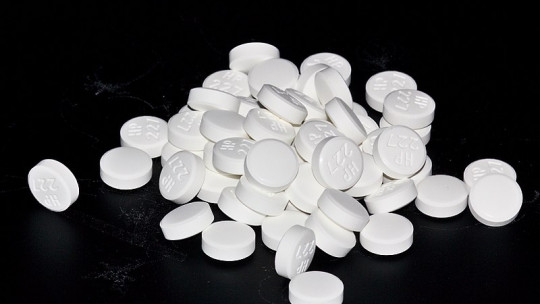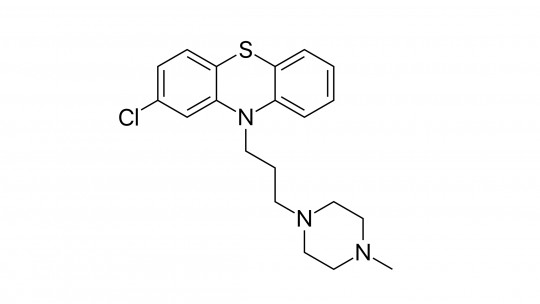
Trifluoperazine is a drug prescribed to treat some manifestations of schizophrenia. This is because it has important effects on the mesolimbic pathways that regulate the release of dopamine. It is also a drug that is not sold anywhere and is subject to medical prescription.
In this article we will see what trifluoperazine is how it acts on the limbic system, what are its indications and side effects.
What is Trifluoperazine?
Trifluoperazine is a chemical compound with an antidopaminergic reaction. That is, it acts as an antagonist of dopamine receptors, which has powerful tranquilizing, anxiolytic and antipsychotic effects.
Due to these effects, trifluoperazine It is within the group of typical antipsychotics which are also called conventional antipsychotics with neuroleptic effects (depressants of the central nervous system).
Broadly speaking, it is a drug that reduces the excitation of electrical activity in the brain.
What is it for and in what disorders is it used?
Trifluoperazine is prescribed to treat some manifestations of the diagnosis of schizophrenia and its main objective is to reduce psychotic experiences. Due to its important sedative action, it is commonly recommended in acute attacks of schizophrenia with intense symptoms of anxiety and mania. Its non-prolonged use is also recommended to treat anxiety symptoms that have not responded to other medications.
This medicine is purchased with a doctor’s prescription and is marketed under different names, which depend on the country. Some of the most common are Cuait Trifluoperazina, Eskazine, Estelazine, Tristazine and Stelazine and their tablet presentation for oral administration. In the case of Spain, it has stopped being marketed since the beginning of 2018. However, there are some generic presentations and it is also distributed by import.
Mechanism of action
Although this mechanism is not precisely defined, different research has linked anti-dopaminergic actions with the reduction of psychotic experiences. “Antidopaminergic actions” are those that produce a blockade of postsynaptic receptors in mesolimbic cortical pathways.
The latter is one of the dopaminergic pathways in the brain that begins in the midbrain and ends in the limbic system (passing through the amygdala, hippocampus and prefrontal cortex, among other areas). The mesolimbic pathway is one that has been significantly related to situations such as emotional regulation, motivation, emotional gratification and reward mechanisms The main neurotransmitter that acts within this pathway is dopamine.
Due to its effects in terms of emotional and behavioral regulation, the activity of the mesolimbic pathway It is associated with the behavioral and psychological manifestations of schizophrenia More specifically with the manifestations of what has been called “positive symptoms” or “psychosis”, where the experiences of hearing voices or depersonalization, among others, are very present.
There is a dopaminergic hypothesis that says that these latter experiences are related to hyperactivity of the mesolimbic pathways in the brain, which has led to the development of drugs, such as trifluoperazine, that act as blockers of dopamine receptors. It is expected that in the long term, trifluoperazine can prevent new psychotic outbreaks.
Side effects and contraindications
The dopaminergic action not only has neuroleptic effects in reducing psychotic manifestations, but also has effects on other neuronal receptors and on other systems beyond the central nervous system, for example on the endocrinological system or the metabolic system.
Within the central nervous system, and since trifluoperazine also impacts other pathways (not only the mesolimbic), it can produce some reactions such as drowsiness, dizziness, decreased alertness and reaction capacity, photosensitivity and some visual alterations.
Additionally, the use of trifluoperazine can generate more serious adverse reactions such as constant and involuntary motor agitation, combined with periods of extremely slow movements. In relation to other systems, such as the metabolic or endocrine system, it can cause constipation, reduced sexual activity, hyperglycemia, among other reactions.
In the case of prescription or taking of excessive doses, as well as in the case of abrupt withdrawal of the drug, seizures, loss of consciousness, fever, tachycardia and liver failure have occurred in high doses, neuroleptic malignant syndrome, among other reactions. adverse events that can be fatal.
Its use is not recommended during pregnancy and lactation and should be avoided when mixed with other narcotics, anesthetics, sedatives and alcoholic beverages (otherwise the likelihood of adverse reactions will increase).
Older adults are especially sensitive to the effects of this medication, so it is recommended to take special precautions in this case. It is especially contraindicated in the case of people with dementia (because it increases the risk of cardiovascular accident and mortality), it is used only if other pharmacological options have not worked and it is recommended not to prolong treatment for more than 3 months. The same in the case of people who have glaucoma, angina pectoris and other associated medical conditions.








